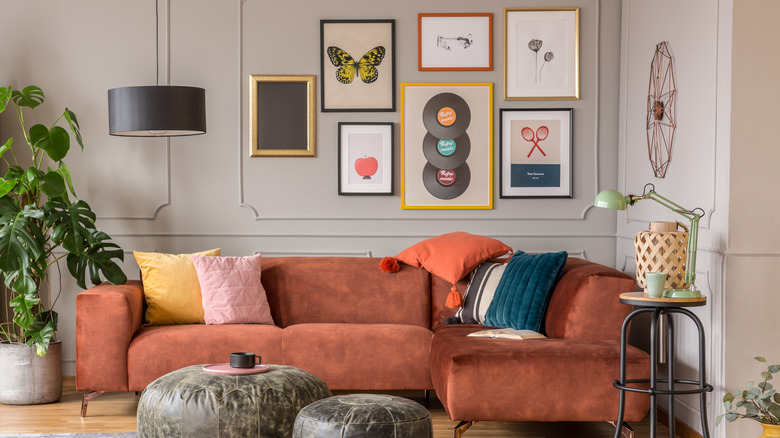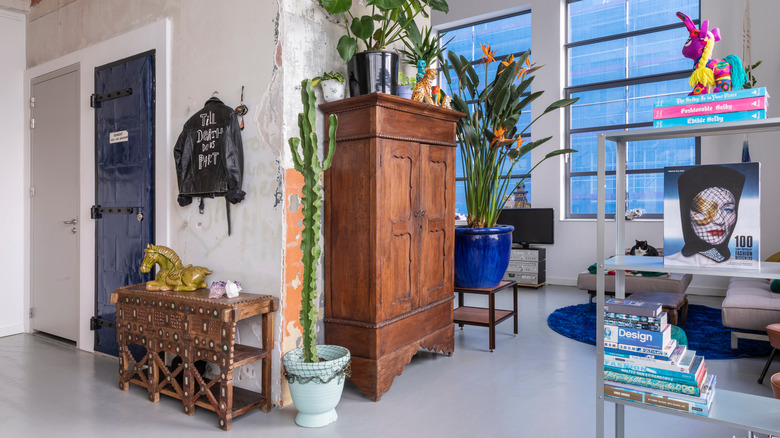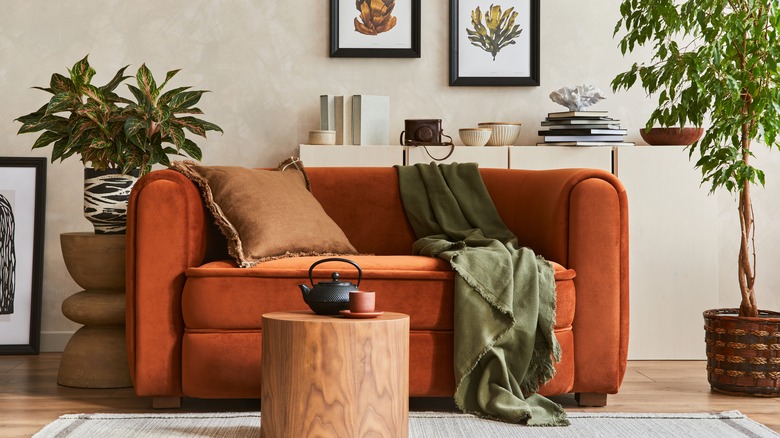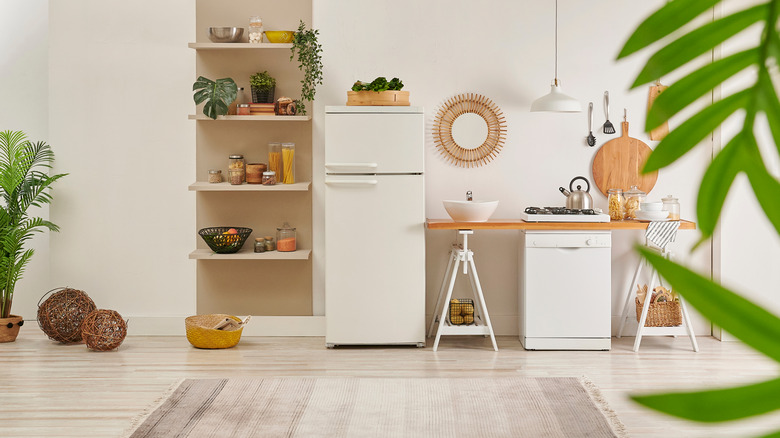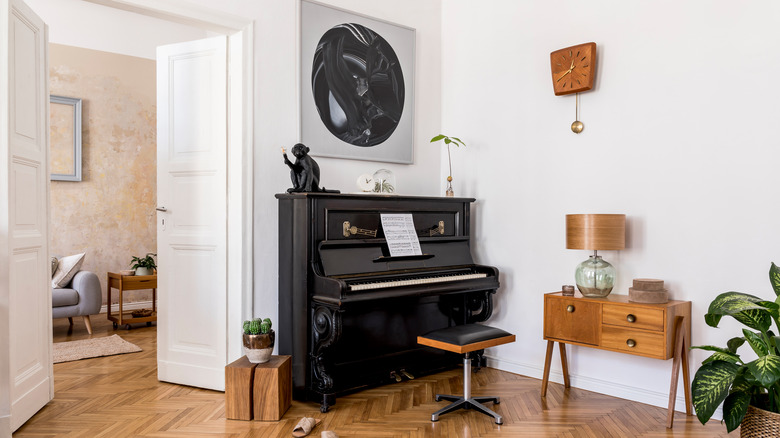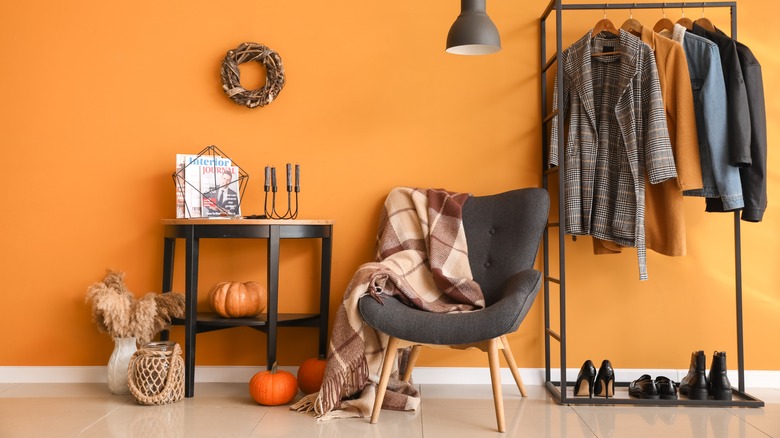5 Tips For Perfecting Slow Decorating
When you're ready to refresh your wardrobe, it can be tempting to overhaul any closet space with cheap and trendy clothing pieces. This practice is known as "fast fashion," and according to Forbes, it not only hurts our wallets, but also disempowers women and is detrimental to the planet.
Just like fast fashion, "fast furniture" shopping is an ever-growing market, churning out cheaply made pieces and trendy home décor at a lightning-fast pace. According to waste management group Recycle Track Systems, Americans threw away approximately 15.6 million tons of furnishing waste in 2017, including furniture, carpets, rugs, home décor, and more. Similarly to secondhand shopping and sustainable fashion, "slow decorating" has emerged as a direct response to the fast-furniture industry.
In a nutshell, slow decorating is the practice of curating your home's décor over time. Instead of rushing to stores and filling your basket with cheap, trendy items, slow decorating encourages homeowners to invest in secondhand, vintage, handmade, and high-quality items. In addition to helping homeowners create more thoughtfully designed homes, slow decorating supports mindful budgeting, sustainable interior décor, and caring for items you already own.
1. Embrace your unique tastes
Slow decorating is all about self-expression. When undertaking this practice, it's important to focus on collecting pieces that speak to your individuality or spark a positive memory. It can take time to discover these pieces, but the goal is to develop a well-rounded and personalized home. If you're unsure about your personal home décor style, designer Brandie Stoeck of Stoeck Interiors recommends browsing Pinterest and taking design quizzes for inspiration. Researching current home design trends may also help you discover buzzwords that will guide you in the right direction.
Don't be afraid to mix home décor styles either; not everything has to fit a certain design aesthetic or be a neutral color scheme. In fact, interior designer Maria Bowers recommends mixing interior design styles to create a home that feels more interesting and personal to you. When you discover an item at the store, market, or secondhand shop, ask yourself, "What part of me does this item speak to? How does this reflect my interests or passions?" Of course, the items that best reflect your interests and passions don't have to match to be cohesive. People are complex, and when you follow your heart, your space will reflect your rich and interesting personality.
2. Know when to splurge
The perfect furniture only comes around once in a while. When you invest in pieces you love — and take good care of them — they can last a lifetime. As such, save some money each month and look out for big-ticket items that make a statement. The most important items to splurge on? Couches, mattresses, and dining tables, according to American Lifestyle Magazine. The hunt may require some patience, but it will be well worth it in the end. After all, it's better to save and splurge on the perfect, impactful piece than it is to purchase multiple meaningless items.
Some people rely on small and cheap items to decorate their space, but this isn't the best way to go about creating a comfortable home. Excess stuff can make a room feel cluttered, distracting, and incohesive. In an interview with Forbes, interior designer Karen Howes states that every home ought to have a few investment pieces or collector's items, like artwork, mirrors, or bold furniture. She suggests placing your statement pieces in a prominent, visible area, such as an entryway. When guests walk in the door, they'll immediately gain a sense of your personal style that carries through the rest of your home.
3. Collect décor with purpose
Collecting functional home décor is a crucial tip, especially if you live in a small space or apartment. Decorative items add personality to a room, but filling your home with knick-knacks, plastic décor, and random signage will make the space feel cluttered. Great home décor should be both beautiful and purposeful, so look for stuff that serves a dual purpose. For example, you could stash votive candles in a ceramic jar on your table or keep magazines in a patterned box on your bookshelf. You don't even have to buy bookends to keep books from slipping; instead, look for heavyweight items, like handmade sculptures, potted plants, or even large stones, collected from your travels.
On the flip side, something more utilitarian can also be decorative! Cooking utensils, kitchen appliances, and storage solutions don't have to be boring. Spend a little more on these or DIY them so you're proud to show them off. Buzzfeed suggests investing in pieces like a storage ottoman, colorful cookware, and decorative wall hooks to add personality to the space and truly make your home feel like your own. When guests walk into your home, they'll be able to immediately sense the care and intention you've put into everything.
4. Consider materials and maintenance
Will pet hair stick to that vintage velvet sofa? Do fingerprints on glass tables bother you? Are those pillow covers washable? Before bringing a new piece into your home, consider the care and maintenance that will be necessary to keep it looking nice. Cheap, build-from-a-box furniture may be easy to clean, but it won't hold up to years of use and multiple moves. Furniture made with high-quality materials can last forever, but it will require some dusting, polishing, and dedication on your part.
Look around your home too; you may not even need to buy anything to achieve the look you want. Many people still throw away their old furniture when it gets tattered or falls out of fashion, but there is some good news: The upholstery industry seems to be on the rise in recent years, indicating that people are starting to take better care of their items and upcycle old pieces (via Pell Research). Slow decorating highly encourages secondhand shopping, but used items aren't always in the best condition. Before you give up on that tattered ottoman or scuffed table, consider how you might be able to give it new life. Paint is cheap, and a little creativity can go a long way when it comes to refreshing old furniture and décor.
5. Be picky with seasonal décor
Everyone loves to freshen up their home for the changing seasons, but seasonal clutter is a real detriment to the well-curated home. When it's not on display, seasonal items end up in boxes and closets, taking up space in your home and your mind. These decorations also fall in and out of style rather quickly. You probably won't like them as much a decade from now, but they'll forever have an impact on the planet. If you want to embrace slow decorating, but still love to celebrate the seasons in your home, avoid overspending on cheap décor items. Instead, look for natural, high-quality décor that would fit seamlessly into your home's year-round aesthetic.
For example, avoid tacky fall décor, like scarecrow dolls, Styrofoam pumpkins, and random signs that say "hello fall." These tend to look more tacky than timeless, and they don't say much about your personal style. Instead, look for vintage or handmade pieces that evoke the "mood" of autumn, like a leather camera case, hand-knit blanket, set of amber glass jars, or wooden drink coasters. Of course, not everything has to be expensive or old to look good; it's okay to enjoy a bright orange pumpkin here and there, but opt for the real thing so that your home feels more genuine.
